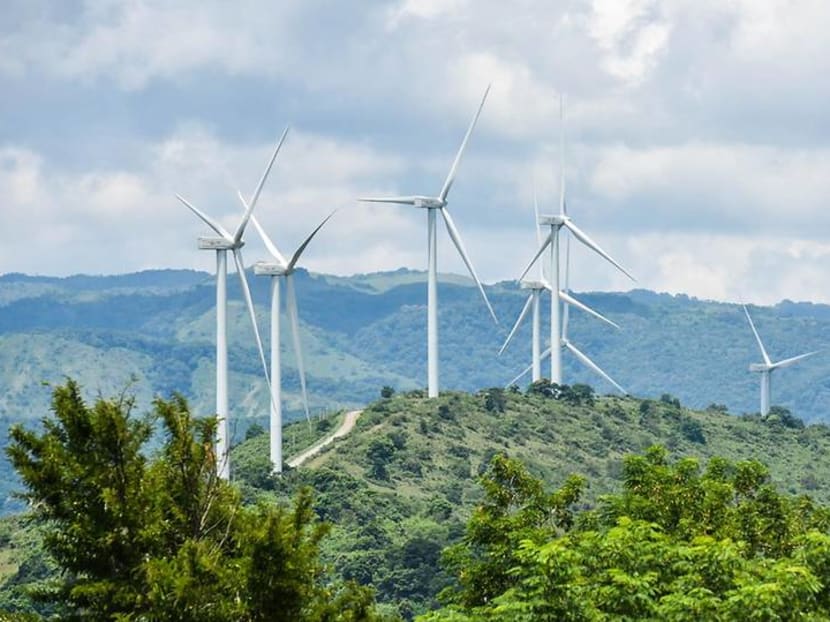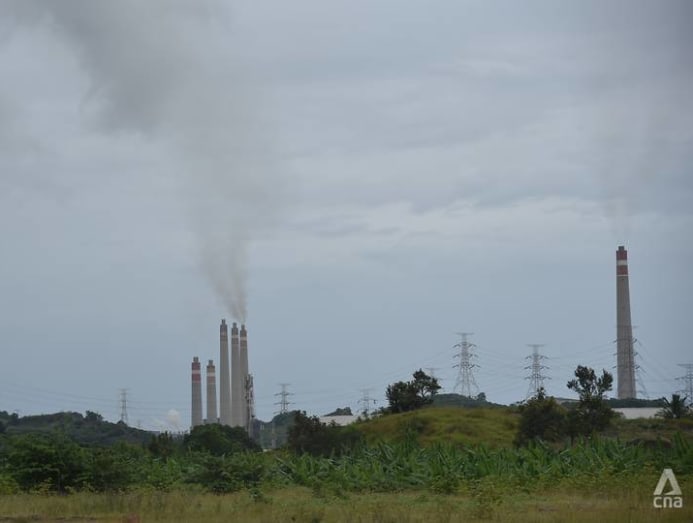Commentary: Renewables are an expensive substitute for Indonesia’s coal dependence
Indonesia’s transition from coal won’t be easy, given its reliance on coal for cheap electricity and challenges to replacing it with renewables, says Norton Rose Fulbright’s Andrew Digges.

The Sidrap wind farm is an unusual sight in the Indonesian countryside. (Photo: Jack Board)
SINGAPORE: Fossil fuels came under renewed scrutiny at the 26th Conference of the Parties of the UNFCCC (COP26) in Glasgow last week.
Indonesia has come under increasing pressure to tackle its significant reliance on coal.
Economic development and poverty reduction remain the Indonesian government’s primary goals. A stable democracy of 270 million people with consistent economic growth, the country still has a significant portion of its population living in poverty.
Maintaining growth will likely require ongoing reliance on coal for power. According to the International Energy Agency, 63 per cent of Indonesia’s electricity generated in 2020 came from coal-fired power. A mere 0.2 per cent came from solar, wind and waste.
Indonesia, the world’s largest thermal coal exporter, is also expanding coal mining and exports.
In fact, coal production surged 320 per cent from 2005 to 2019. Given high global coal prices and the influence of the Indonesian Coal Mining Association, it seems unlikely Indonesian mining and coal exports will diminish soon.
Following the recent recommendations of the Intergovernmental Panel on Climate Change report, most nations have been setting higher nationally determined contributions (NDCs) to the reduction of carbon dioxide or equivalent greenhouse gas (GHG) emissions.
Yet, while Indonesia is playing its part by updating its NDCs under the Paris Agreement to increase its emission reduction targets, and by initiating steps to reduce its reliance on coal in recent months, important questions remain about how realistic these plans are.
INDONESIA’S RECENT PUSH TO DECARBONISE
The government has ramped up its plans to reduce Indonesia’s reliance on coal in the lead-up to COP26.
In May, state-owned power utility Perusahaan Listrik Negara (PLN) announced plans to halt all new coal-fired power plants after 2023 and to decommission all coal-fired power plants by 2056. The Ministry of Energy and Mineral Resources (MEMR) announced it will not approve new coal projects unless already under construction or financed.
In July, the government submitted an updated NDC, setting out renewed commitments to reduce GHG emissions and details of how it will do so. Various government representatives referred to Indonesia achieving “net-zero” by 2060.
In October, authorities released a new National Electricity Business Supply Plan for 2021 to 2030 (known as a RUPTL) that aims to achieve these commitments.
That same month, the government passed a new carbon tax to be applied to excessive GHG emissions from coal-fired power plants from April 2022, although at a relatively low rate of IDR30,000 (US$2.10) per tonne of CO2.
Indonesia plans to finalise a presidential decree on the economic value of carbon and develop a carbon trading mechanism by 2025.
CHEAP POWER REMAINS IMPORTANT
Under Indonesia’s NDC submitted to the United Nations in July, Indonesia’s main commitment is to achieve a 29 per cent to 41 per cent reduction in GHG emissions by 2030, compared to likely GHG emissions under a “business as usual” scenario with no countermeasures, with the upper bound conditional on receiving international support.
A significant portion of the proposed emission reductions (58 per cent) will come from changes in land and forest use, with a pledge that forestry and land use will reach peak emissions by 2030. The next biggest contributor is the “energy sector” (38 per cent).
But the reality is that cheap power remains very important to Indonesia’s ongoing growth and coal remains a relatively cheap fuel, difficult to abandon.
The latest RUPTL, which sets out MEMR and PLN’s blueprint for new electricity-generating capacity in Indonesia, has inconsistencies with the updated NDC and earlier coal phase-out commitments.
PLN plans to add 40.6 GW of new generating capacity by 2030. The majority of the new capacity (51.6 per cent) is intended to come from renewable energy - a welcome increase from 29.6 per cent renewables in the previous RUPTL.
However, while the RUPTL appears to support plans to cease coal-fired power development, stating “there is no plan for the development of new coal-fired power plants in this RUPTL except for those that have achieved financial close or commenced construction”, the new plan nevertheless provides for 13.8GW of new coal-fired power (34 per cent of the total) with the last new plant coming online in 2027.
PLN intends to procure a substantial majority of new coal-fired power as privately funded independent power producer projects but it’s hard to see how that will materialise given that sources of international funding for coal-fired power projects have all but evaporated.
Many international financiers have said they will no longer support coal. President Xi Jinping announced in September that China would not build any new coal-fired power projects abroad.
Coal projects without a signed power purchase agreement and committed financing might never be built by the private sector
What substantive outcomes can the global climate conference COP26 produce? CNA's Jaime Ho finds out from Isabelle de Lovinfosse, who works for the British Government as the Head of Southeast Asia COP26 Strategy:
CHALLENGES TO MOVING AWAY FROM COAL
Indonesia faces five big challenges to moving away from coal. First, Indonesia’s proposed reductions in energy sector emissions appear to rely largely on the application of clean coal technologies, including co-firing of coal plants with biomass and the use of carbon capture and storage and integrated gasification combined cycle technologies.
But many commentators, including the Institute for Energy Economics and Financial Analysis, have expressed doubt over whether such novel technologies will be viable soon.
Second, Indonesia’s plan to decommission all coal-fired power means that electricity supply will need to come from other sources, especially renewable energy to replace coal, as laid out in the RUTPL.
However, despite substantial declines in renewable energy costs over the last decade, shifting towards renewables remains a challenge for PLN because “the price of environmentally friendly power generation technology is still high”.

The high cost of grid and power plant upgrades and battery storage solutions to allow variable renewable energy exacerbate this issue. In the RUPTL, PLN flags the need for additional government support and private sector funding for transmission upgrades and expansion.
Third, the lack of a clear and conducive regulatory environment, along with missing clarity on renewable energy tariffs and governmental support, are also restricting the development of renewable energy. The MEMR has just released new regulations on rooftop solar as it recognises that only a meagre 31.8 MW out of 32.5 GW of potential rooftop solar power has been installed, far behind neighbouring countries.
Fourth, the present renewable energy pricing regime provides for tariffs at or below the average cost of power in relevant regions, restricting the viability of many renewable energy projects in Indonesia, particularly in major electricity demand locations where average costs are lower.
The market is waiting for the MEMR to enact a more favourable regime. A pricing regime that attracts foreign investors will be necessary to realise the latest renewable energy plans, whether through fiscal incentives, capital costs subsidies or higher tariffs.
Last, Indonesia also has relatively limited viable energy resources. Enveloping the equatorial zone, only a few locations have good offshore wind potential.
Related:
A World Bank report on solar potential shows some decent irradiation data, particularly in the heavily populated Java-Bali and West and East Nusa Tenggara regions. However, the higher population density means land scarcity, which makes large scale solar development costlier.
LIMITS TO WHAT INDONESIA CAN ACHIEVE
Given fiscal constraints and renewable resource restrictions, there are limits to how much Indonesia can achieve on decarbonisation. In that context, its declared commitments should be applauded and encouraged.
The success of Indonesia’s higher NDC objectives and decarbonisation plans depends heavily on two key factors.
First, it will require the imminent implementation of a regulatory and fiscal environment that is substantially more conducive to the development of renewable energy and stable transmission systems.
Second, it will need substantial financial and technological assistance from the international community.
Indonesia acknowledged the need for outside help. Last week at COP26, President Jokowi asked developed economies to contribute more funds and share technology in order for Indonesia to be able to ramp up its climate change efforts.
To tackle the climate change challenge facing us all, the international financial and technological communities must respond to Indonesia’s call for assistance to meet its goals.
Andrew Digges is a projects partner at Norton Rose Fulbright LLP in Singapore.







